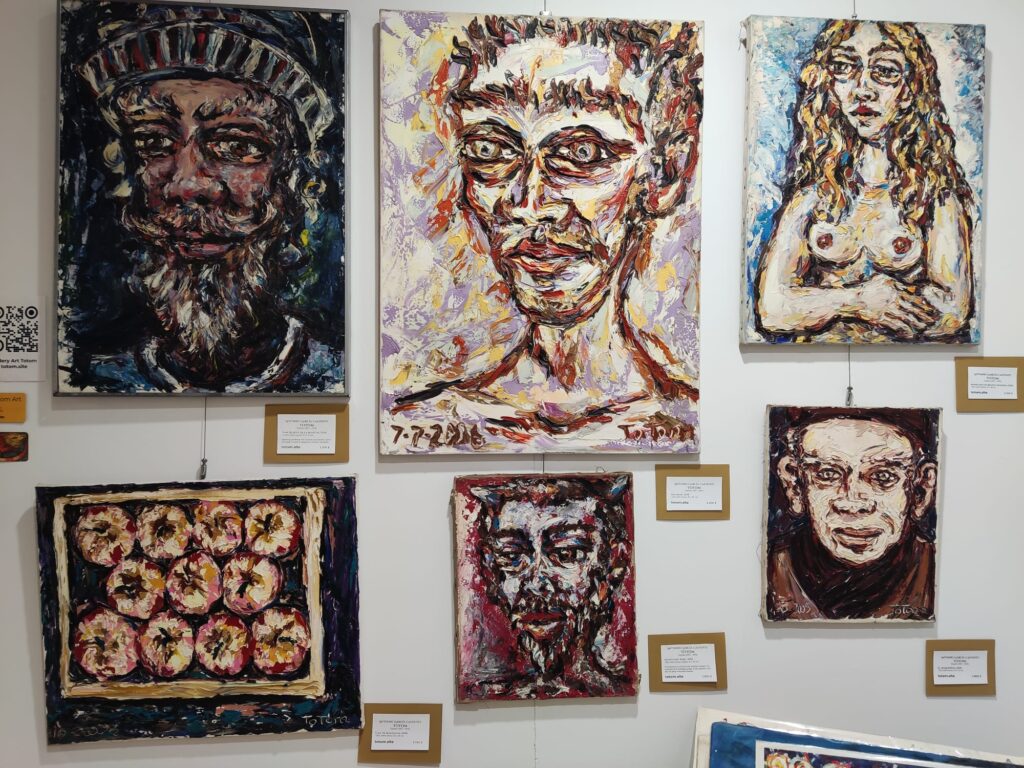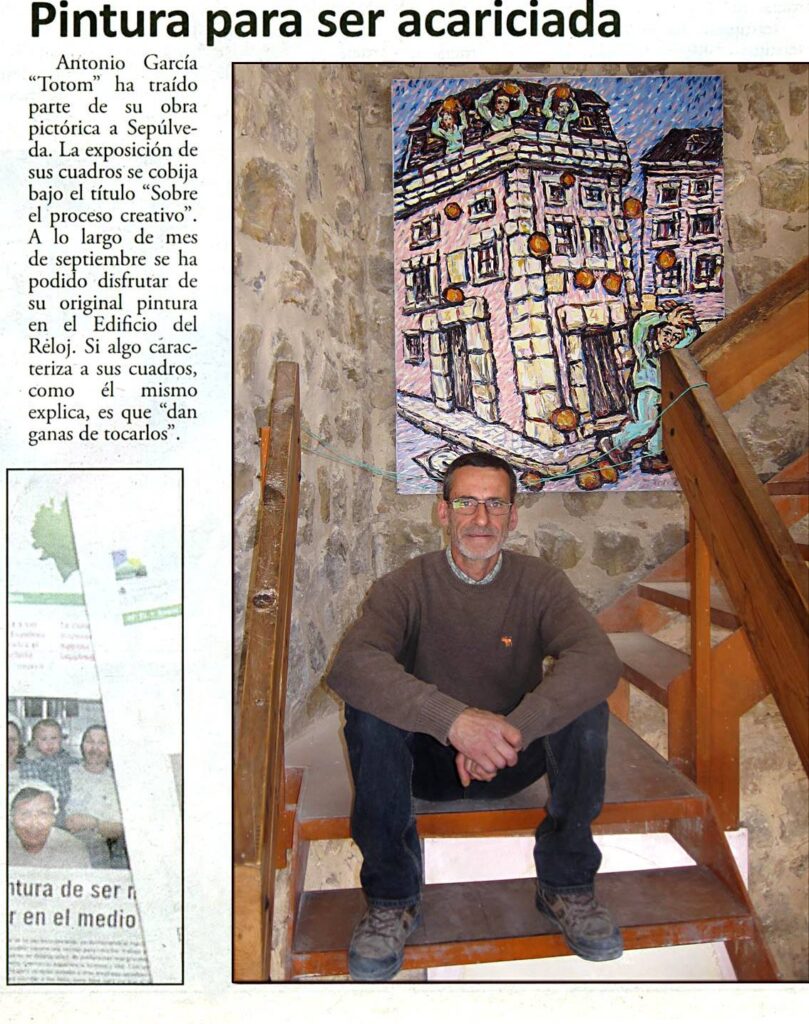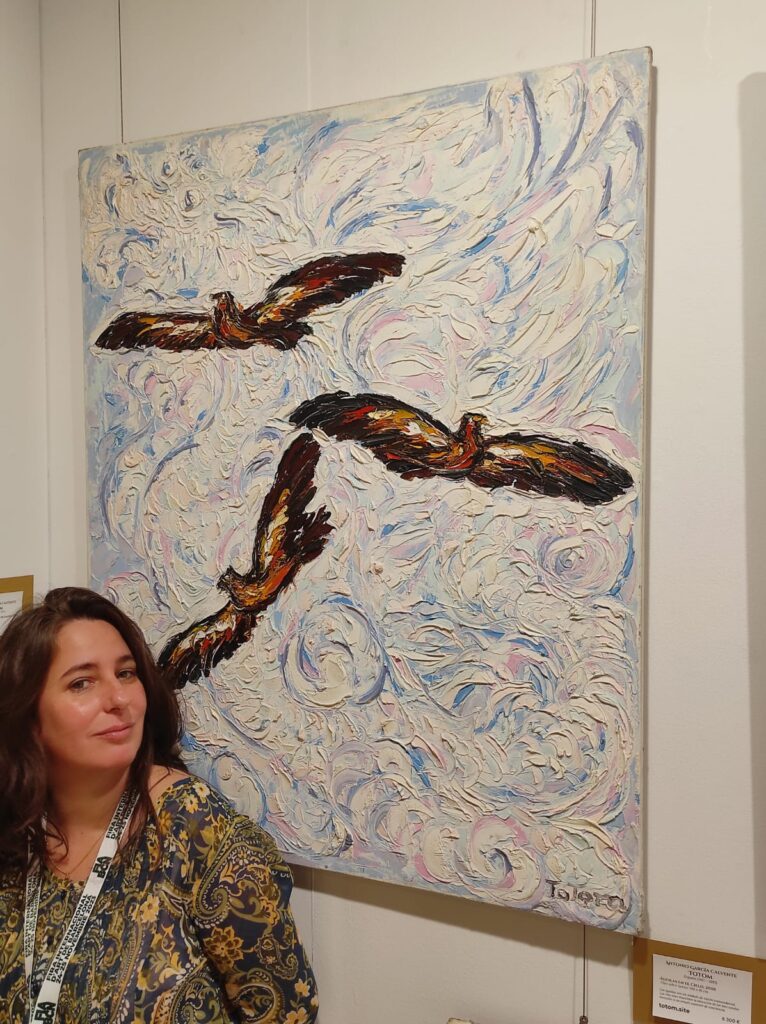How to visit an art exhibition?
We often wonder how to visit an art exhibition and get more out of such a beautiful and rewarding experience. Art is complex and often incomprehensible to the viewer. The visitor to a gallery or an exhibition often feels lost or overwhelmed among so many works, often very different from each other.
When the exhibition is individual, they are usually arranged in a certain direction, giving shape to a message, or above all, an intention in the visitor’s gaze.
When the exhibition is collective, the works are usually arranged in an intermittent, random manner, which does not allow us to fully understand what we see.
The aesthetic experience at first sight, the first thing we feel when we see a work of art, our initial opinion, can be suggested by so many things that it is difficult to understand what we are seeing.
Depending on where the work is, the context of the works around it, our emotional state, who we are walking with, even the moment in which we see it, something may seem wonderful to us or we may pass by without paying attention. Now, the challenge also consists of putting aside everything we believe and feel and manage to go deeper and enter the work of art, in order to observe, minimally, the stability, harmony, balance, color, shape, texture or line.
Learning to enjoy art
In this time we have mechanized an easy “like-dislike”, an easy quick judgment, which we make of almost everything we see. Thanks to television, the media, and the possibility of judging from a distance without knowing who we judge, our society has become a society that easily judges who is in front of it, what the other does, without even wanting to understand. .
In some entertainment game shows, we see a jury analyzing each of the artists trying their luck. The spectator, immediately, without knowing dance or singing, without knowing the artists or their effort to be there, becomes a jury as tough as anyone else. And we have all had the opportunity to be next to someone who, with a dark and cold gaze, judges what he does not know, in a hurtful and severe way, insulting and despising those he does not know, thanks to the fact that the screen, the distance, Anonymity allows you to do so.
We see this or that on the Internet, one video or another, and it is easy to fall into easy laughter, judgment, contempt, something that, if we had that person next to us, we would reserve and even worry about doing it.
Thus, our culture has transformed the attitude of the viewer, abandoning the role of surprise and curiosity, to a judicious eye incapable of enjoyment.
At musical concerts I have been able to hear how they judge the clothing of the violinist or pianist; In art exhibitions I have been able to observe how they judge whether the artist is very serious or very happy; In dance they judge the age of the dancers; In singing, if this or that singer has more or less body weight…
The aesthetic of art

The aesthetic of art defines the essence of beauty in works of art. They are the keys that define whether something is more or less beautiful.
Imagine going to a rose garden and analyzing: too small, little color, too tall, too colorful, too faded, too green… The beauty of the garden could not be defined in this way, we would be going through some details such as the whole, the harmony , which evokes us. We would be judging and moving away from the aesthetic perception that naturally occurs in all of us.
In the garden we don’t do this, on the contrary, we know that we have to enjoy it there, we know that it is pure nature. There is no analysis, there is no judgment, there is an enjoyment of the moment, the smell, the harmony that is generated… we try to be part of that harmony, we try to be part of the balance of the garden and the flowers, and then we enjoy what we have around us . The judgmental and cold eye turns off and more subtle concepts appear, our perception and vision transform and relax, we stop being in judgment, in a state of negative alert, waiting for danger and other people’s evil, and the senses open to enjoy.
Our perception of flowers will also change if the garden is very dirty, or if there is a lot of noise, or if there are many children running and screaming calling for our attention. And it will change much more depending on who we are walking with, we will enjoy where we are and what we do more or less depending on who we are with and our conversation. Every detail will completely change the perception of the place.
The perception of art must begin by understanding this. Each of the elements that surround us can completely transform what we are feeling. Our perception can be influenced by countless things. And although, while it is true that there is a unique and personal taste, there are also aesthetic forms and a pictorial balance, as well as artistic keys that will go unnoticed by us if we do not relax and try to delve deeper into what we see.
Artistic quality

Some works are like “pop” music: they are simple, striking, easily repetitive, and anyone, even someone with the worst musical ear, can hum them and imitate the singer.
Other works are like baroque music, they have voices, background, depth… they are complex and very difficult to repeat, to follow, and to hum for those who have a bad musical ear.
Just as in literature, there are books that are easy to understand, and books with great depth and complexity that invite us to reflect and force us to stop at what we have read.
Complexity and depth, meaning and harmony do not imply that a work is better or worse, they are different, with different styles, and created for different moments. Obviously, as with everything, there are fashions and trends, but our role as viewers is not to judge what we see, but to learn to enjoy it.
And if even cows and farm animals can perceive art, since it has been proven that they produce more milk with classical music, but said production is not altered at all or even diminishes with pop or rock music, how can humans be? enjoy and benefit from the harmony and balance of works of art?
We do not need to understand all the nuances of a work of art, nor learn philosophy, nor understand the history of the artist, simply learn to enjoy a walk surrounded by images that evoke the beauty of life.
The artistic quality of each work is complex to understand. Many times we can be faced with what seems to us to be a complex and difficult work, and be faced with something very simple, made using techniques that have been refined and learned over the centuries, similar to craftsmanship and easily imitated by any neophyte artist or artist. even with a computer.
Many times we give too much weight to these techniques, or shapes that we already know, to realism or color balance, and we lose sight of other qualities that will define the real artistic quality of a work of art.
Enjoying a visit to a museum or exhibition
Start and tour of the exhibition
The first thing when entering an exhibition is to empty oneself of intention, of judgment, and try to be there. As in music, many notes will go unnoticed if you are not attentive to what is playing.
Before even reading the artist’s biography, before reading his origin, before being influenced by the context, it is best to delve deeper into the art in front of us, in order to allow our senses, our intuition and our sensitivity to generate an unique and personal experience.
Then it is good to understand if there is a direction that the artist has felt important to point out. If the works invite you to start the exhibition in a certain direction, go ahead. Although many times the artist has wanted to generate a certain dynamic, and perhaps it has its reason for being.
Even with painters like Picasso, when we see his works in the Reina Sofía museum in Madrid, we observe that there is a whole pre-established route until we reach the most complex works. A previously studied route from the aesthetically closest works to the most complex forms, a route that will allow the visitor to go deeper and deeper into the painter’s works of art, and in the end, when reaching the most complex works, they can be integrated and felt in more detail. When a person who has never seen a work by Picasso accesses the most complex forms for the first time, it may be that he does not understand them, that he may not be able to grasp the meaning or sensitivity of them, but if he is faithful to this journey, it is It is easy for even someone who never saw beauty in these works to enjoy and understand them much better.
For this reason, if the artist chose a route, it is good to understand it and try to follow it in order to allow our gaze and perception to be directed on a small journey through art.
Stop and appreciate each work
Once the walk begins, the perception of the pictorial works requires that we stop.
Typically, a visitor takes one look at a work, and based on that first impression, moves on almost immediately to the next. The result is the interaction with the artistic work is usually highly influenced by that entire environment, by its past, by its haste, by the context and above all by cognitive processes.
Firstly, we stop at the approximate distance of twice the diagonal of the pictorial work. This will allow a vision of harmony and the whole of it. The shapes, the balance and above all, the final result of it.
When we stop like this, before a work of art, we do not think or analyze, we simply observe calmly. Just as the building is the final work, but the bricklayer built it stone by stone, in this step we are not analyzing the stones he placed, nor the technique he used, simply the final harmony, the whole.
Once this is done, we approach and see the detail, we observe what caught our attention, the internal composition, or how he achieved the games of lights, shapes…
Later, now understanding better how this work is done, we once again step back and appreciate the whole. How often? Those that we feel appropriate.
Aesthetics at first sight

The visual aesthetic occurs in two stages: the first view that generates an overall impression of the essence of the piece. A more structural sense, a faster meaning, and at the second level, an aesthetic processing generated by a focal investigation that increases information about compositional characteristics and detail.
Aesthetics at first sight usually look for chords of colors and textures that are easily understood by the person observing it, which will mean that a work will look more beautiful or less beautiful depending on the cognitive processes of the viewer. A simpler mind, or a mind with a tendency toward repetitive thoughts, will see more beautiful works with simpler shapes. And a mind with more intelligence, sharp, creative and even quick in developing new thoughts, will observe more beauty in more complex and profound ways.
We also have to differentiate that a person “thinks a lot” does not mean that his thoughts are more or less elaborate. It can refer to mental patterns, or mechanizations of repetitive thoughts.
Regularly observing art, like listening to or reading it, can over time help the mind generate more complex thought processes; In short, we all know that reading more does not help develop intelligence. But, generally, a first view of the work and that initial taste or differentiation of the “beautiful” and the “ugly” will be completely influenced by the quality of the person’s thoughts.
With this we have to understand that the ability for the work to “touch” our heart, or not move our emotion at all, for a work of art to move us more or less, is influenced by our intelligence, our current cognitive processes and the influence of them about our own passions, emotions and feelings.
Therefore, an interesting trick is to do as a baby, or an animal, would do, we simply allow ourselves to be transformed by the harmony and balance that surrounds us, and we observe, not so much what surrounds us, but what that environment produces for us. The transformation that exists in us in that environment. As I said, with so many people claiming that they don’t understand or don’t like classical music, how is it possible that cows produce more milk when they listen to it? Correct harmony, the natural aesthetics and balance of art, is beneficial to everyone, and we are simply seeking to learn to differentiate that balance and harmony from the noise that surrounds us.
Complete tour
Above all, when the work is very extensive, or the exhibition is full of diverse works, or it is a multiple exhibition, the mind requires breaks.
If the structure of the exhibition is previously determined. It is likely that the best works tend to be placed at the end. But in the end, the visitor, especially if he is not used to it, is already tired and only thinks about finishing quickly. That is why it is good to relax as many times as you need, take your mind off everything you have seen and return to it with new energy.
The complete journey of an exhibition is more important than we think. Once again I stop at the analogy with a musical work. We cannot stop a musical work in the middle, it has a beginning and an end, a harmony, it is a whole. It would be like abandoning a book halfway through. It is a story that cannot be stopped.
If the exhibition is about pictorial works that are easier to process aesthetically, then it can be made shorter and easier to digest and understand. But if the exhibition is more complex, or with many diverse artists, it is more complex and challenging to analyze and requires sophistication in the relationship with each work and each style.

Information
Once we allow the senses to do their work, once we allow ourselves to delve into the sensations, the feeling and the emotion of the texture, color, the set of works and the general aesthetics of the art, then we can inform ourselves. Better not before, since that information could influence and alter our perception too much. So at that point, we learn about the artist, the techniques he uses, the media, his origin…
Obviously at this time, the artist’s ego is rewarded. We observe awards and praise to this or that person highlighting his suffering or victimizing his life. Nowadays, so far removed from the perception of art, we prioritize the life of the artist, his origin, his problems and the need to overcome him. And that empathy and love for others is interesting, although it is also a deception to value art based on the artist. It would be like valuing a child based on his parents. Each work is unique, it is a creation for the world. The artist, if he does not know how to remain in the background, will not allow that work to be transformed into a universal and timeless language. If he does not know how to abandon his ego, his fame, his name and his history, his work will be subject to a temporary fashion, and tomorrow we will know at most his name and his history, but not what he did. Because over time, it matters little who this or that person was, but what I believe and the mark he left does matter.
It is natural that today we spend too much time entertained by today’s things, but when analyzing art and delving into its aesthetics, the information is unnecessary and will only influence our emotional and sensitive perception, forcing us to feel attracted to colors, shapes, or structures that have little of art, but a lot of advertising, politics and important current events.
Therefore, the best information at the end.
Closing of the exhibition
Once you close a book, it is good to sit down for a few minutes and reflect on it. Once a musical work has finished, it is good to feel the silence that has been generated for a few moments. Once an exhibition is over, it is important to sit down and feel the change in us, what it has generated in us, calm the mind and listen.
Art is nothing more than an evocation, art evokes, but what does it evoke? It can evoke harmony, sensitivity, sadness, anger, fear, love… art evokes something in us. Art is not that something that evokes, it is what evokes it.
So, after perceiving it and surrounding ourselves with it, it is good to sit down and recognize what it has evoked in us.
